

What this handout is about
This handout will explain what qualifiers are and how you can use them wisely.
Introduction
Qualifiers and intensifiers are words or phrases that are added to another word to modify its meaning, either by limiting it (He was somewhat busy) or by enhancing it (The dog was very cute). Qualifiers can play an important role in your writing, giving your reader clues about how confident you feel about the information you’re presenting. In fact, “hedging” (as it is sometimes called) is an important feature of academic writing, because academic writers need to clearly indicate whether they think claims are certain, likely, unlikely, or just false. But excessive use of qualifiers can make you sound unsure of your facts; it can also make your writing too informal.
Qualifiers can be your friends
Qualifiers are often necessary, such as when your evidence or your claim is open to doubt. In such cases, using a qualifier allows you to present your findings with what we can call “confident uncertainty,” which reflects a need to be cautious and critical about the data you’re presenting. Sometimes you may be required to present your ideas before you have had a chance to fully interpret your research findings. At other times, you may want to remind readers of the limitations of your particular research.
Here are some words and phrases that can help you indicate uncertainty:
It’s also very important to distinguish between absolute or universal claims (in which you are asserting that something is true always and everywhere) and more particular claims (in which you are asserting something but recognizing that your claim has limits). Let’s take a look at some absolute words and some more qualified alternatives:
| ABSOLUTE | QUALIFIED |
|---|---|
| Will | May, might, could |
| Forms of “be” (am, is, are, was, were) | May be, might have been, may have been |
| All | Many, most, some, numerous, countless, a majority |
| Every | (Same as “all”) |
| None/no | Few, not many, a small number, hardly any, a minority |
| Always | Often, frequently, commonly, for a long time, usually, sometimes, repeatedly |
| Never | Rarely, infrequently, sporadically, seldom |
| Certainly | Probably, possibly |
| Impossible | Unlikely, improbable, doubtful |
How much doubt do you want to create?
In most academic writing, you make an argument to support a thesis. To make a strong argument, you’ll need to convince readers of your points. Consider these two sentences:
President Nixon probably resigned as a result of the Watergate cover-up.
President Nixon resigned as a result of the Watergate cover-up.
The first sentence makes your reader doubt the conclusion you’ve arrived at; the latter sentence leaves no doubt about your argument for the causes of Nixon’s resignation. How can you know which sentence to choose? You’ll need to think about the impact your choices will have on your reader.
Qualifiers express doubt; they leave your reader wondering if you know what you’re talking about. Constructions like it appears that and it seems likely that diminish the strength of your claims. Sometimes that’s exactly what you want, when you don’t want to overstate your case and cannot justify making a stronger, more direct claim. But if you are confident of your evidence, using strong qualifiers like these can lead your reader to doubt whether you know what you are talking about or to think that you are not willing to take responsibility for your ideas.
Consider the two examples below. Does the writer sound confident in her understanding of the theories of Freud and Weber?
It appears that Freud believed the unconscious played a significant role in behavior.
Max Weber seems to argue that capitalism arises partly out of Protestant values.
Does Freud in fact think that the unconscious affects people’s behavior? Does Weber really think capitalism arises from Protestant values? If so, the writer should probably just make those claims, without the qualifiers. Here are some examples of words to keep an eye on (in addition to the qualifiers already listed above):
- Essentially
Qualifiers and your writing style
Writing that contains too many qualifiers can sound unclear and wordy. We often rely on qualifiers—especially intensifiers—because we either don’t know or don’t take the time to find the appropriate word. Instead we construct our meaning by employing a not-quite-right word with a qualifier added to strengthen or to tone down a noun or verb.
Anna Karenina is a somewhat admirable character. Better: Anna Karenina is a sympathetic character.
December in Moscow is really cold. Better: December in Moscow is freezing .
The theme of community is very important in Russian literature. Better: The theme of community is central in Russian literature.
In each of the above examples, the second sentence employs a word with a more precise meaning and is more concise.
“She was very happy” doesn’t capture the nuances that can be expressed by “overjoyed,” “thrilled,” or “ecstatic.” Pay special attention to these commonly overused intensifiers:
The qualifier habit
Using lots of qualifiers can become a habit. Sometimes it carries over from the way you speak—perhaps you are a dramatic storyteller who uses lots of intensifiers to express your strong feelings. Sometimes it reflects your relationship to writing, or to your readers—perhaps you feel that you are a “bad writer” and cannot write with confidence, or perhaps you are writing for an intimidating audience, and you are using qualifiers to make your claims as humble as possible in hopes of avoiding criticism or disagreement. While you can certainly compensate for a habit of overusing qualifiers by adding another stage to your editing process (as we’ll discuss in a moment), it may also be worth thinking about how to change your attitudes and practices. If you are using qualifiers to try to create interest and drama, perhaps you could explore other strategies that would be more appropriate for academic writing, like using stronger verbs and including more interesting details. If you are using qualifiers because of a lack of confidence, ask yourself: do I need to do more research to feel confident of my claims? Do I need to talk with my regular readers and let them know more about the kinds of feedback that are, and are not, helpful for me? Do I need to practice getting feedback from some “friendly” readers in order to feel more comfortable with that aspect of the writing process?
Suppose you’ve realized that you use the words on the above lists too often and have resolved to cut back. But how? One method is to read through your paper and circle all the adverbs and adjectives. Then examine each one and see whether it accurately and concisely conveys your intended meaning.
It proved to be very hard to overturn Plessy v. Ferguson. Better: It proved to be difficult to overturn Plessy v. Ferguson.
In recent years the Electoral College has become very controversial. Better: In recent years the Electoral College has become controversial.
The House Ways and Means Committee is basically one of the most powerful congressional committees. Better: The House Ways and Means Committee is one of the most powerful congressional committees.
We hope that this handout will help you make confident, appropriate choices about using qualifiers in your writing!
You may reproduce it for non-commercial use if you use the entire handout and attribute the source: The Writing Center, University of North Carolina at Chapel Hill
Make a Gift
Have a language expert improve your writing
Run a free plagiarism check in 10 minutes, generate accurate citations for free.
- Knowledge Base
- How to write a literary analysis essay | A step-by-step guide
How to Write a Literary Analysis Essay | A Step-by-Step Guide
Published on January 30, 2020 by Jack Caulfield . Revised on August 14, 2023.
Literary analysis means closely studying a text, interpreting its meanings, and exploring why the author made certain choices. It can be applied to novels, short stories, plays, poems, or any other form of literary writing.
A literary analysis essay is not a rhetorical analysis , nor is it just a summary of the plot or a book review. Instead, it is a type of argumentative essay where you need to analyze elements such as the language, perspective, and structure of the text, and explain how the author uses literary devices to create effects and convey ideas.
Before beginning a literary analysis essay, it’s essential to carefully read the text and c ome up with a thesis statement to keep your essay focused. As you write, follow the standard structure of an academic essay :
- An introduction that tells the reader what your essay will focus on.
- A main body, divided into paragraphs , that builds an argument using evidence from the text.
- A conclusion that clearly states the main point that you have shown with your analysis.
Instantly correct all language mistakes in your text
Upload your document to correct all your mistakes in minutes

Table of contents
Step 1: reading the text and identifying literary devices, step 2: coming up with a thesis, step 3: writing a title and introduction, step 4: writing the body of the essay, step 5: writing a conclusion, other interesting articles.
The first step is to carefully read the text(s) and take initial notes. As you read, pay attention to the things that are most intriguing, surprising, or even confusing in the writing—these are things you can dig into in your analysis.
Your goal in literary analysis is not simply to explain the events described in the text, but to analyze the writing itself and discuss how the text works on a deeper level. Primarily, you’re looking out for literary devices —textual elements that writers use to convey meaning and create effects. If you’re comparing and contrasting multiple texts, you can also look for connections between different texts.
To get started with your analysis, there are several key areas that you can focus on. As you analyze each aspect of the text, try to think about how they all relate to each other. You can use highlights or notes to keep track of important passages and quotes.
Language choices
Consider what style of language the author uses. Are the sentences short and simple or more complex and poetic?
What word choices stand out as interesting or unusual? Are words used figuratively to mean something other than their literal definition? Figurative language includes things like metaphor (e.g. “her eyes were oceans”) and simile (e.g. “her eyes were like oceans”).
Also keep an eye out for imagery in the text—recurring images that create a certain atmosphere or symbolize something important. Remember that language is used in literary texts to say more than it means on the surface.
Narrative voice
Ask yourself:
- Who is telling the story?
- How are they telling it?
Is it a first-person narrator (“I”) who is personally involved in the story, or a third-person narrator who tells us about the characters from a distance?
Consider the narrator’s perspective . Is the narrator omniscient (where they know everything about all the characters and events), or do they only have partial knowledge? Are they an unreliable narrator who we are not supposed to take at face value? Authors often hint that their narrator might be giving us a distorted or dishonest version of events.
The tone of the text is also worth considering. Is the story intended to be comic, tragic, or something else? Are usually serious topics treated as funny, or vice versa ? Is the story realistic or fantastical (or somewhere in between)?
Consider how the text is structured, and how the structure relates to the story being told.
- Novels are often divided into chapters and parts.
- Poems are divided into lines, stanzas, and sometime cantos.
- Plays are divided into scenes and acts.
Think about why the author chose to divide the different parts of the text in the way they did.
There are also less formal structural elements to take into account. Does the story unfold in chronological order, or does it jump back and forth in time? Does it begin in medias res —in the middle of the action? Does the plot advance towards a clearly defined climax?
With poetry, consider how the rhyme and meter shape your understanding of the text and your impression of the tone. Try reading the poem aloud to get a sense of this.
In a play, you might consider how relationships between characters are built up through different scenes, and how the setting relates to the action. Watch out for dramatic irony , where the audience knows some detail that the characters don’t, creating a double meaning in their words, thoughts, or actions.
Here's why students love Scribbr's proofreading services
Discover proofreading & editing
Your thesis in a literary analysis essay is the point you want to make about the text. It’s the core argument that gives your essay direction and prevents it from just being a collection of random observations about a text.
If you’re given a prompt for your essay, your thesis must answer or relate to the prompt. For example:
Essay question example
Is Franz Kafka’s “Before the Law” a religious parable?
Your thesis statement should be an answer to this question—not a simple yes or no, but a statement of why this is or isn’t the case:
Thesis statement example
Franz Kafka’s “Before the Law” is not a religious parable, but a story about bureaucratic alienation.
Sometimes you’ll be given freedom to choose your own topic; in this case, you’ll have to come up with an original thesis. Consider what stood out to you in the text; ask yourself questions about the elements that interested you, and consider how you might answer them.
Your thesis should be something arguable—that is, something that you think is true about the text, but which is not a simple matter of fact. It must be complex enough to develop through evidence and arguments across the course of your essay.
Say you’re analyzing the novel Frankenstein . You could start by asking yourself:
Your initial answer might be a surface-level description:
The character Frankenstein is portrayed negatively in Mary Shelley’s Frankenstein .
However, this statement is too simple to be an interesting thesis. After reading the text and analyzing its narrative voice and structure, you can develop the answer into a more nuanced and arguable thesis statement:
Mary Shelley uses shifting narrative perspectives to portray Frankenstein in an increasingly negative light as the novel goes on. While he initially appears to be a naive but sympathetic idealist, after the creature’s narrative Frankenstein begins to resemble—even in his own telling—the thoughtlessly cruel figure the creature represents him as.
Remember that you can revise your thesis statement throughout the writing process , so it doesn’t need to be perfectly formulated at this stage. The aim is to keep you focused as you analyze the text.
Finding textual evidence
To support your thesis statement, your essay will build an argument using textual evidence —specific parts of the text that demonstrate your point. This evidence is quoted and analyzed throughout your essay to explain your argument to the reader.
It can be useful to comb through the text in search of relevant quotations before you start writing. You might not end up using everything you find, and you may have to return to the text for more evidence as you write, but collecting textual evidence from the beginning will help you to structure your arguments and assess whether they’re convincing.
To start your literary analysis paper, you’ll need two things: a good title, and an introduction.
Your title should clearly indicate what your analysis will focus on. It usually contains the name of the author and text(s) you’re analyzing. Keep it as concise and engaging as possible.
A common approach to the title is to use a relevant quote from the text, followed by a colon and then the rest of your title.
If you struggle to come up with a good title at first, don’t worry—this will be easier once you’ve begun writing the essay and have a better sense of your arguments.
“Fearful symmetry” : The violence of creation in William Blake’s “The Tyger”
The introduction
The essay introduction provides a quick overview of where your argument is going. It should include your thesis statement and a summary of the essay’s structure.
A typical structure for an introduction is to begin with a general statement about the text and author, using this to lead into your thesis statement. You might refer to a commonly held idea about the text and show how your thesis will contradict it, or zoom in on a particular device you intend to focus on.
Then you can end with a brief indication of what’s coming up in the main body of the essay. This is called signposting. It will be more elaborate in longer essays, but in a short five-paragraph essay structure, it shouldn’t be more than one sentence.
Mary Shelley’s Frankenstein is often read as a crude cautionary tale about the dangers of scientific advancement unrestrained by ethical considerations. In this reading, protagonist Victor Frankenstein is a stable representation of the callous ambition of modern science throughout the novel. This essay, however, argues that far from providing a stable image of the character, Shelley uses shifting narrative perspectives to portray Frankenstein in an increasingly negative light as the novel goes on. While he initially appears to be a naive but sympathetic idealist, after the creature’s narrative Frankenstein begins to resemble—even in his own telling—the thoughtlessly cruel figure the creature represents him as. This essay begins by exploring the positive portrayal of Frankenstein in the first volume, then moves on to the creature’s perception of him, and finally discusses the third volume’s narrative shift toward viewing Frankenstein as the creature views him.
Some students prefer to write the introduction later in the process, and it’s not a bad idea. After all, you’ll have a clearer idea of the overall shape of your arguments once you’ve begun writing them!
If you do write the introduction first, you should still return to it later to make sure it lines up with what you ended up writing, and edit as necessary.
The body of your essay is everything between the introduction and conclusion. It contains your arguments and the textual evidence that supports them.
Paragraph structure
A typical structure for a high school literary analysis essay consists of five paragraphs : the three paragraphs of the body, plus the introduction and conclusion.
Each paragraph in the main body should focus on one topic. In the five-paragraph model, try to divide your argument into three main areas of analysis, all linked to your thesis. Don’t try to include everything you can think of to say about the text—only analysis that drives your argument.
In longer essays, the same principle applies on a broader scale. For example, you might have two or three sections in your main body, each with multiple paragraphs. Within these sections, you still want to begin new paragraphs at logical moments—a turn in the argument or the introduction of a new idea.
Robert’s first encounter with Gil-Martin suggests something of his sinister power. Robert feels “a sort of invisible power that drew me towards him.” He identifies the moment of their meeting as “the beginning of a series of adventures which has puzzled myself, and will puzzle the world when I am no more in it” (p. 89). Gil-Martin’s “invisible power” seems to be at work even at this distance from the moment described; before continuing the story, Robert feels compelled to anticipate at length what readers will make of his narrative after his approaching death. With this interjection, Hogg emphasizes the fatal influence Gil-Martin exercises from his first appearance.
Topic sentences
To keep your points focused, it’s important to use a topic sentence at the beginning of each paragraph.
A good topic sentence allows a reader to see at a glance what the paragraph is about. It can introduce a new line of argument and connect or contrast it with the previous paragraph. Transition words like “however” or “moreover” are useful for creating smooth transitions:
… The story’s focus, therefore, is not upon the divine revelation that may be waiting beyond the door, but upon the mundane process of aging undergone by the man as he waits.
Nevertheless, the “radiance” that appears to stream from the door is typically treated as religious symbolism.
This topic sentence signals that the paragraph will address the question of religious symbolism, while the linking word “nevertheless” points out a contrast with the previous paragraph’s conclusion.
Using textual evidence
A key part of literary analysis is backing up your arguments with relevant evidence from the text. This involves introducing quotes from the text and explaining their significance to your point.
It’s important to contextualize quotes and explain why you’re using them; they should be properly introduced and analyzed, not treated as self-explanatory:
It isn’t always necessary to use a quote. Quoting is useful when you’re discussing the author’s language, but sometimes you’ll have to refer to plot points or structural elements that can’t be captured in a short quote.
In these cases, it’s more appropriate to paraphrase or summarize parts of the text—that is, to describe the relevant part in your own words:
Receive feedback on language, structure, and formatting
Professional editors proofread and edit your paper by focusing on:
- Academic style
- Vague sentences
- Style consistency
See an example

The conclusion of your analysis shouldn’t introduce any new quotations or arguments. Instead, it’s about wrapping up the essay. Here, you summarize your key points and try to emphasize their significance to the reader.
A good way to approach this is to briefly summarize your key arguments, and then stress the conclusion they’ve led you to, highlighting the new perspective your thesis provides on the text as a whole:
If you want to know more about AI tools , college essays , or fallacies make sure to check out some of our other articles with explanations and examples or go directly to our tools!
- Ad hominem fallacy
- Post hoc fallacy
- Appeal to authority fallacy
- False cause fallacy
- Sunk cost fallacy
College essays
- Choosing Essay Topic
- Write a College Essay
- Write a Diversity Essay
- College Essay Format & Structure
- Comparing and Contrasting in an Essay
(AI) Tools
- Grammar Checker
- Paraphrasing Tool
- Text Summarizer
- AI Detector
- Plagiarism Checker
- Citation Generator
By tracing the depiction of Frankenstein through the novel’s three volumes, I have demonstrated how the narrative structure shifts our perception of the character. While the Frankenstein of the first volume is depicted as having innocent intentions, the second and third volumes—first in the creature’s accusatory voice, and then in his own voice—increasingly undermine him, causing him to appear alternately ridiculous and vindictive. Far from the one-dimensional villain he is often taken to be, the character of Frankenstein is compelling because of the dynamic narrative frame in which he is placed. In this frame, Frankenstein’s narrative self-presentation responds to the images of him we see from others’ perspectives. This conclusion sheds new light on the novel, foregrounding Shelley’s unique layering of narrative perspectives and its importance for the depiction of character.
Cite this Scribbr article
If you want to cite this source, you can copy and paste the citation or click the “Cite this Scribbr article” button to automatically add the citation to our free Citation Generator.
Caulfield, J. (2023, August 14). How to Write a Literary Analysis Essay | A Step-by-Step Guide. Scribbr. Retrieved June 25, 2024, from https://www.scribbr.com/academic-essay/literary-analysis/
Is this article helpful?

Jack Caulfield
Other students also liked, how to write a thesis statement | 4 steps & examples, academic paragraph structure | step-by-step guide & examples, how to write a narrative essay | example & tips, what is your plagiarism score.
Last places remaining for July 14th and July 28th courses . Enrol now and join students from 175 countries for the summer of a lifetime
- 9 Essay Pitfalls and How to Avoid Them

Writing essays is a mainstay of education from secondary school through to university, and no matter how well you know the subject in question, if you can’t write a good essay, your marks will suffer. Different academic traditions approach essays in different ways, so in this article we’re going to focus on the kind of essay expected in British schools and universities; the kind you’d be taught how to write, for instance, at our Oxford summer school . That kind of essay should put forward an argument, develop it through several different points, and conclude in a way that marries the points together and reinforces your original argument. It sounds straightforward, but as anyone who’s ever had to write an essay knows, it isn’t always so simple. Here are the types of error people make when writing essays, and how you can avoid them.
1. The list
Perhaps the most common type of bad essay is the list. This can be a result of bad essay writing, but bad question-setting also plays a role. Take the classic essay topic of the causes of the First World War . One way of phrasing a question on this could be simply, “What were the causes of the First World War?” It naturally lends itself to a list; you could almost answer in bullet point. To avoid the list, you’d have to distort the question. Another question could explore the same area of knowledge, but encourage a better-structured essay, such as “Was the First World War inevitable?” or “Was imperialism responsible for the First World War?” You’ll know if you’ve fallen into the trap of writing a list if words like “moreover”, “furthermore” and “additionally” are creeping into your essay more than “therefore” and “however”. To avoid just writing a list, first see if the question invites a list, and if so, reframe it in your head in order to construct an argument. In the First World War example, you could say, “It is popularly believed that the chief cause of the First World War was… but the causes of war in fact went much deeper…” – and then you’re arguing, rather than listing, right away. Consider also which items on your list are more important or less important, and how they interact with each other, and make sure that you come to a firm conclusion that picks a stance and doesn’t settle for “there were many causes, all important” or related waffle.
2. The weighing scales

The “weighing scales” approach to writing an essay is when you have a choice of two options, and you come down firmly on the fence. This is particularly common in essays on a difficult or controversial topic, such as, “Would justice be better served if criminals were given longer prison sentences?” The weighing scales approach would say, “on the one hand, some criminals are treated too leniently… on the other hand, longer prison sentences can increase recidivism… then again, longer sentences may act as more of a deterrent… but they also cost the state a lot of money.” The essay then concludes that there are strong arguments in favour of both sides, and perhaps that more research is needed (even when there has been plenty of research on the topic). In some academic disciplines and some cultures, the “weighing scales” approach to an essay is considered actively desirable. But that’s not the case for British universities. While it’s important to mention both sides (more on that in a moment), an essay should advance an argument. If you conclude that both sides have merit, your argument should at least propose a way of navigating between them. Make sure that by the end of your essay, your reader knows what your opinion is.
3. The polemic

The direct opposite of the “weighing scales” approach is the polemic. In this kind of essay, your reader is in no doubt at all about what your point of view is; unfortunately, they’ve heard rather too much of it and rather too little of anything else. Continuing on the same example as above, in the polemic, you might argue that prison is wholly negative, based on punishment not rehabilitation, leading to worse outcomes for prisoners than alternatives like community service, and introducing ‘new’ criminals to experienced ones so that they end up learning not how to avoid crime, but how to become better at it. While all those points are reasonable, the issue is that the other side is altogether missing. In a “polemic”-style essay, the writer rejects the other side so much that they won’t even discuss their ideas. That’s not persuasive; you also need to spend time acknowledging and refuting the alternative point of view. You don’t need to accept it, only explain where it comes from, and why it’s mistaken.
4. The literature review

A literature review is a perfectly valid piece of writing: it’s where you look at everything that’s been written on a particular topic, and compare, contrast and analyse the writers’ stances without interjecting too much of your own views. It’s a standard part of theses and dissertations, allowing you to establish the thoughts of the major authorities in the field so that you can refer to them later in the piece without the need for a lengthy introduction. But if you’re not supposed to be writing a literature review, then your essay shouldn’t resemble one. After all, it’s about assessing your knowledge, ideas and opinions, not everyone else’s. When a subject has been written about extensively, it can feel impossible to produce an original thought on it. You can end up attributing every point you want to make to another writer, because otherwise it can feel like plagiarism. But while every point might have been said before, your route through them and your reasoning will still be original. Make sure your own point of view is established, without relying too heavily on the literature.
5. The plagiarist
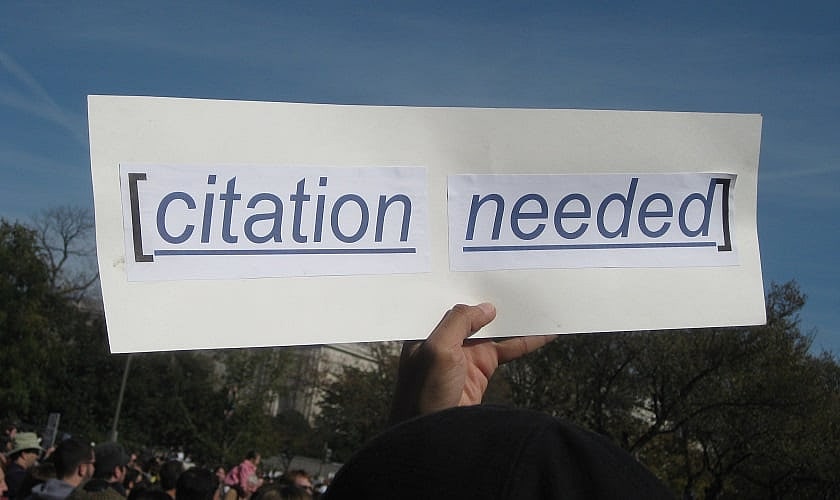
The opposite of the literature review, the “plagiarist” is the essay that passes off a little too much as your own work when it really ought to be credited to someone else. To be clear, we’re not talking about genuine copy-and-paste plagiarism (or the same thing with a couple of words tweaked and examples changed, which is no better) – that’s not a pitfall, that’s grounds for expulsion. This is instead where you’ve maybe read an idea, forgotten which article or book you read it in – or even that it wasn’t your idea in the first place – and put it in an essay without a citation. But even if you didn’t do it deliberately, it’s likely to be frowned on by your teachers. The only way to avoid the “plagiarist” essay is to take more thorough notes when you’re working on an essay. If you read something interesting, even if you don’t think it’s relevant, make a note of where you found it in case you do want to refer back to it. If you’re feeling really lazy, just take a photo of the details on your phone. Then you can make sure you’re not taking credit for ideas that aren’t your own.
6. The long introduction

This one is reasonably self-explanatory – it’s when it feel like the majority of the essay is introduction or scene-setting, and you never really get to the point. To go back to the earlier example of an essay on the causes of the First World War, a “long introduction” essay would spend paragraphs describing the context, the different countries and personalities involved, not to mention their histories – and then, running out of word count, would cram in a paragraph or two at the end about how all of this resulted in war. A “long introduction” essay can be the result of misjudging the word count (and more on that later) but it can also be the result of knowing a great deal about a topic and not wanting to commit to an argument. Avoid the long introduction by making sure your argument is clear from your introduction onwards. Sometimes students also structure an essay by starting with their weaker points and leading to their best point, as a kind of rhetorical crescendo. This can be effective if done well, but it can also lead to a “long introduction” essay as your reader has to sit through paragraphs of muddle waiting for you to get to your real knock-out idea.
7. The textbook

Another perfectly valid piece of writing that nonetheless makes for a poor essay is the “textbook” approach. Instead of writing an essay – with points, examples, explanations and an argument running through it all like a stick of rock – you write an explainer on the topic. This is akin to the list, but typically better written and structured. A “textbook” essay is not necessarily a bad piece of work; it’s just not what’s being asked of you when you write an essay. Sometimes, when students are shy about expressing their opinion, a “textbook”-style essay is the end result. They outline all the examples and explanations that they might have included without committing to the points. The end result is an essay where the student’s point of view could perhaps be inferred from the approach taken, but where it isn’t made explicit. If this is you, try to express your opinion more assertively; you might be avoiding saying things like “I believe” (as usually essays shouldn’t contain the first person) but try phrases like “it is clear that” or that such and such an alternative argument “is flawed”.
8. The revision notes

The “revision notes” essay is not an essay that resembles revision notes; instead, it’s an essay that’s so painfully light on detail that it reads like you used revision notes rather than doing the reading or research that you were supposed to. It skims over dates; it focuses only on the main characters of a novel; where a reader might expect it to cite another theorist, it avoids it with vague statements such as “many people have argued that…”. Assertions go unexplained and unproven. Typically the reason a student writes an essay like this is because they’re out of their depth; they haven’t done the work or understood the topic well enough to go into any more detail. If you’re finding that you’re writing this sort of essay even when you do know your topic, go through and see where more detail could be added. Even something like adding dates for events in brackets can give the sense that you know what you’re talking about. Similarly, try to use examples that aren’t the most obvious or default choice for the point that you’re making. It might feel unnecessary when you know the person marking your essay knows these details already, but you have to prove that you know the details as well.
9. The word count challenge

This goes in both directions – the essays where you’re restricted to 2,000 words and you feel like you could write a novel on the subject, and the ones where you have to write 2,000 words and you feel like you could barely manage a paragraph. Every student will have developed some tricks for getting round this, such as changing the margins or font size, or adding or removing contractions and adjectives. Of course, your teachers are wise to this. It’s much better to write an essay that’s appropriate for the length set in the first place, which means planning it out carefully. If you have what feels like too few points for the word count, can you go into more detail on those points? And if you have too much to say, can your points be grouped together for more of an overview that skips out the finer detail? Or perhaps your approach is too broad, and you can stick more closely to the question asked to condense what you want to say. This is particularly relevant for exams, where realising that you have more to say than time to say it in can be disastrous; the way to avoid it is practising until you have a better sense for how much content you need for a certain exam duration or word count.
Image credits: writing an essay ; list ; scales ; speaker ; books ; citation ; long book ; textbooks ; post-it note ; miniature book .
- USC Libraries
- Research Guides
Organizing Your Social Sciences Research Paper
- Academic Writing Style
- Purpose of Guide
- Design Flaws to Avoid
- Independent and Dependent Variables
- Glossary of Research Terms
- Reading Research Effectively
- Narrowing a Topic Idea
- Broadening a Topic Idea
- Extending the Timeliness of a Topic Idea
- Applying Critical Thinking
- Choosing a Title
- Making an Outline
- Paragraph Development
- Research Process Video Series
- Executive Summary
- The C.A.R.S. Model
- Background Information
- The Research Problem/Question
- Theoretical Framework
- Citation Tracking
- Content Alert Services
- Evaluating Sources
- Primary Sources
- Secondary Sources
- Tiertiary Sources
- Scholarly vs. Popular Publications
- Qualitative Methods
- Quantitative Methods
- Insiderness
- Using Non-Textual Elements
- Limitations of the Study
- Common Grammar Mistakes
- Writing Concisely
- Avoiding Plagiarism
- Footnotes or Endnotes?
- Further Readings
- Generative AI and Writing
- USC Libraries Tutorials and Other Guides
- Bibliography
Academic writing refers to a style of expression that researchers use to define the intellectual boundaries of their disciplines and specific areas of expertise. Characteristics of academic writing include a formal tone, use of the third-person rather than first-person perspective (usually), a clear focus on the research problem under investigation, and precise word choice. Like specialist languages adopted in other professions, such as, law or medicine, academic writing is designed to convey agreed meaning about complex ideas or concepts within a community of scholarly experts and practitioners.
Academic Writing. Writing Center. Colorado Technical College; Hartley, James. Academic Writing and Publishing: A Practical Guide . New York: Routledge, 2008; Ezza, El-Sadig Y. and Touria Drid. T eaching Academic Writing as a Discipline-Specific Skill in Higher Education . Hershey, PA: IGI Global, 2020.
Importance of Good Academic Writing
The accepted form of academic writing in the social sciences can vary considerable depending on the methodological framework and the intended audience. However, most college-level research papers require careful attention to the following stylistic elements:
I. The Big Picture Unlike creative or journalistic writing, the overall structure of academic writing is formal and logical. It must be cohesive and possess a logically organized flow of ideas; this means that the various parts are connected to form a unified whole. There should be narrative links between sentences and paragraphs so that the reader is able to follow your argument. The introduction should include a description of how the rest of the paper is organized and all sources are properly cited throughout the paper.
II. Tone The overall tone refers to the attitude conveyed in a piece of writing. Throughout your paper, it is important that you present the arguments of others fairly and with an appropriate narrative tone. When presenting a position or argument that you disagree with, describe this argument accurately and without loaded or biased language. In academic writing, the author is expected to investigate the research problem from an authoritative point of view. You should, therefore, state the strengths of your arguments confidently, using language that is neutral, not confrontational or dismissive.
III. Diction Diction refers to the choice of words you use. Awareness of the words you use is important because words that have almost the same denotation [dictionary definition] can have very different connotations [implied meanings]. This is particularly true in academic writing because words and terminology can evolve a nuanced meaning that describes a particular idea, concept, or phenomenon derived from the epistemological culture of that discipline [e.g., the concept of rational choice in political science]. Therefore, use concrete words [not general] that convey a specific meaning. If this cannot be done without confusing the reader, then you need to explain what you mean within the context of how that word or phrase is used within a discipline.
IV. Language The investigation of research problems in the social sciences is often complex and multi- dimensional . Therefore, it is important that you use unambiguous language. Well-structured paragraphs and clear topic sentences enable a reader to follow your line of thinking without difficulty. Your language should be concise, formal, and express precisely what you want it to mean. Do not use vague expressions that are not specific or precise enough for the reader to derive exact meaning ["they," "we," "people," "the organization," etc.], abbreviations like 'i.e.' ["in other words"], 'e.g.' ["for example"], or 'a.k.a.' ["also known as"], and the use of unspecific determinate words ["super," "very," "incredible," "huge," etc.].
V. Punctuation Scholars rely on precise words and language to establish the narrative tone of their work and, therefore, punctuation marks are used very deliberately. For example, exclamation points are rarely used to express a heightened tone because it can come across as unsophisticated or over-excited. Dashes should be limited to the insertion of an explanatory comment in a sentence, while hyphens should be limited to connecting prefixes to words [e.g., multi-disciplinary] or when forming compound phrases [e.g., commander-in-chief]. Finally, understand that semi-colons represent a pause that is longer than a comma, but shorter than a period in a sentence. In general, there are four grammatical uses of semi-colons: when a second clause expands or explains the first clause; to describe a sequence of actions or different aspects of the same topic; placed before clauses which begin with "nevertheless", "therefore", "even so," and "for instance”; and, to mark off a series of phrases or clauses which contain commas. If you are not confident about when to use semi-colons [and most of the time, they are not required for proper punctuation], rewrite using shorter sentences or revise the paragraph.
VI. Academic Conventions Among the most important rules and principles of academic engagement of a writing is citing sources in the body of your paper and providing a list of references as either footnotes or endnotes. The academic convention of citing sources facilitates processes of intellectual discovery, critical thinking, and applying a deliberate method of navigating through the scholarly landscape by tracking how cited works are propagated by scholars over time . Aside from citing sources, other academic conventions to follow include the appropriate use of headings and subheadings, properly spelling out acronyms when first used in the text, avoiding slang or colloquial language, avoiding emotive language or unsupported declarative statements, avoiding contractions [e.g., isn't], and using first person and second person pronouns only when necessary.
VII. Evidence-Based Reasoning Assignments often ask you to express your own point of view about the research problem. However, what is valued in academic writing is that statements are based on evidence-based reasoning. This refers to possessing a clear understanding of the pertinent body of knowledge and academic debates that exist within, and often external to, your discipline concerning the topic. You need to support your arguments with evidence from scholarly [i.e., academic or peer-reviewed] sources. It should be an objective stance presented as a logical argument; the quality of the evidence you cite will determine the strength of your argument. The objective is to convince the reader of the validity of your thoughts through a well-documented, coherent, and logically structured piece of writing. This is particularly important when proposing solutions to problems or delineating recommended courses of action.
VIII. Thesis-Driven Academic writing is “thesis-driven,” meaning that the starting point is a particular perspective, idea, or position applied to the chosen topic of investigation, such as, establishing, proving, or disproving solutions to the questions applied to investigating the research problem. Note that a problem statement without the research questions does not qualify as academic writing because simply identifying the research problem does not establish for the reader how you will contribute to solving the problem, what aspects you believe are most critical, or suggest a method for gathering information or data to better understand the problem.
IX. Complexity and Higher-Order Thinking Academic writing addresses complex issues that require higher-order thinking skills applied to understanding the research problem [e.g., critical, reflective, logical, and creative thinking as opposed to, for example, descriptive or prescriptive thinking]. Higher-order thinking skills include cognitive processes that are used to comprehend, solve problems, and express concepts or that describe abstract ideas that cannot be easily acted out, pointed to, or shown with images. Think of your writing this way: One of the most important attributes of a good teacher is the ability to explain complexity in a way that is understandable and relatable to the topic being presented during class. This is also one of the main functions of academic writing--examining and explaining the significance of complex ideas as clearly as possible. As a writer, you must adopt the role of a good teacher by summarizing complex information into a well-organized synthesis of ideas, concepts, and recommendations that contribute to a better understanding of the research problem.
Academic Writing. Writing Center. Colorado Technical College; Hartley, James. Academic Writing and Publishing: A Practical Guide . New York: Routledge, 2008; Murray, Rowena and Sarah Moore. The Handbook of Academic Writing: A Fresh Approach . New York: Open University Press, 2006; Johnson, Roy. Improve Your Writing Skills . Manchester, UK: Clifton Press, 1995; Nygaard, Lynn P. Writing for Scholars: A Practical Guide to Making Sense and Being Heard . Second edition. Los Angeles, CA: Sage Publications, 2015; Silvia, Paul J. How to Write a Lot: A Practical Guide to Productive Academic Writing . Washington, DC: American Psychological Association, 2007; Style, Diction, Tone, and Voice. Writing Center, Wheaton College; Sword, Helen. Stylish Academic Writing . Cambridge, MA: Harvard University Press, 2012.
Strategies for...
Understanding Academic Writing and Its Jargon
The very definition of research jargon is language specific to a particular community of practitioner-researchers . Therefore, in modern university life, jargon represents the specific language and meaning assigned to words and phrases specific to a discipline or area of study. For example, the idea of being rational may hold the same general meaning in both political science and psychology, but its application to understanding and explaining phenomena within the research domain of a each discipline may have subtle differences based upon how scholars in that discipline apply the concept to the theories and practice of their work.
Given this, it is important that specialist terminology [i.e., jargon] must be used accurately and applied under the appropriate conditions . Subject-specific dictionaries are the best places to confirm the meaning of terms within the context of a specific discipline. These can be found by either searching in the USC Libraries catalog by entering the disciplinary and the word dictionary [e.g., sociology and dictionary] or using a database such as Credo Reference [a curated collection of subject encyclopedias, dictionaries, handbooks, guides from highly regarded publishers] . It is appropriate for you to use specialist language within your field of study, but you should avoid using such language when writing for non-academic or general audiences.
Problems with Opaque Writing
A common criticism of scholars is that they can utilize needlessly complex syntax or overly expansive vocabulary that is impenetrable or not well-defined. When writing, avoid problems associated with opaque writing by keeping in mind the following:
1. Excessive use of specialized terminology . Yes, it is appropriate for you to use specialist language and a formal style of expression in academic writing, but it does not mean using "big words" just for the sake of doing so. Overuse of complex or obscure words or writing complicated sentence constructions gives readers the impression that your paper is more about style than substance; it leads the reader to question if you really know what you are talking about. Focus on creating clear, concise, and elegant prose that minimizes reliance on specialized terminology.
2. Inappropriate use of specialized terminology . Because you are dealing with concepts, research, and data within your discipline, you need to use the technical language appropriate to that area of study. However, nothing will undermine the validity of your study quicker than the inappropriate application of a term or concept. Avoid using terms whose meaning you are unsure of--do not just guess or assume! Consult the meaning of terms in specialized, discipline-specific dictionaries by searching the USC Libraries catalog or the Credo Reference database [see above].
Additional Problems to Avoid
In addition to understanding the use of specialized language, there are other aspects of academic writing in the social sciences that you should be aware of. These problems include:
- Personal nouns . Excessive use of personal nouns [e.g., I, me, you, us] may lead the reader to believe the study was overly subjective. These words can be interpreted as being used only to avoid presenting empirical evidence about the research problem. Limit the use of personal nouns to descriptions of things you actually did [e.g., "I interviewed ten teachers about classroom management techniques..."]. Note that personal nouns are generally found in the discussion section of a paper because this is where you as the author/researcher interpret and describe your work.
- Directives . Avoid directives that demand the reader to "do this" or "do that." Directives should be framed as evidence-based recommendations or goals leading to specific outcomes. Note that an exception to this can be found in various forms of action research that involve evidence-based advocacy for social justice or transformative change. Within this area of the social sciences, authors may offer directives for action in a declarative tone of urgency.
- Informal, conversational tone using slang and idioms . Academic writing relies on excellent grammar and precise word structure. Your narrative should not include regional dialects or slang terms because they can be open to interpretation. Your writing should be direct and concise using standard English.
- Wordiness. Focus on being concise, straightforward, and developing a narrative that does not have confusing language . By doing so, you help eliminate the possibility of the reader misinterpreting the design and purpose of your study.
- Vague expressions (e.g., "they," "we," "people," "the company," "that area," etc.). Being concise in your writing also includes avoiding vague references to persons, places, or things. While proofreading your paper, be sure to look for and edit any vague or imprecise statements that lack context or specificity.
- Numbered lists and bulleted items . The use of bulleted items or lists should be used only if the narrative dictates a need for clarity. For example, it is fine to state, "The four main problems with hedge funds are:" and then list them as 1, 2, 3, 4. However, in academic writing, this must then be followed by detailed explanation and analysis of each item. Given this, the question you should ask yourself while proofreading is: why begin with a list in the first place rather than just starting with systematic analysis of each item arranged in separate paragraphs? Also, be careful using numbers because they can imply a ranked order of priority or importance. If none exists, use bullets and avoid checkmarks or other symbols.
- Descriptive writing . Describing a research problem is an important means of contextualizing a study. In fact, some description or background information may be needed because you can not assume the reader knows the key aspects of the topic. However, the content of your paper should focus on methodology, the analysis and interpretation of findings, and their implications as they apply to the research problem rather than background information and descriptions of tangential issues.
- Personal experience. Drawing upon personal experience [e.g., traveling abroad; caring for someone with Alzheimer's disease] can be an effective way of introducing the research problem or engaging your readers in understanding its significance. Use personal experience only as an example, though, because academic writing relies on evidence-based research. To do otherwise is simply story-telling.
NOTE: Rules concerning excellent grammar and precise word structure do not apply when quoting someone. A quote should be inserted in the text of your paper exactly as it was stated. If the quote is especially vague or hard to understand, consider paraphrasing it or using a different quote to convey the same meaning. Consider inserting the term "sic" in brackets after the quoted text to indicate that the quotation has been transcribed exactly as found in the original source, but the source had grammar, spelling, or other errors. The adverb sic informs the reader that the errors are not yours.
Academic Writing. The Writing Lab and The OWL. Purdue University; Academic Writing Style. First-Year Seminar Handbook. Mercer University; Bem, Daryl J. Writing the Empirical Journal Article. Cornell University; College Writing. The Writing Center. University of North Carolina; Murray, Rowena and Sarah Moore. The Handbook of Academic Writing: A Fresh Approach . New York: Open University Press, 2006; Johnson, Eileen S. “Action Research.” In Oxford Research Encyclopedia of Education . Edited by George W. Noblit and Joseph R. Neikirk. (New York: Oxford University Press, 2020); Oppenheimer, Daniel M. "Consequences of Erudite Vernacular Utilized Irrespective of Necessity: Problems with Using Long Words Needlessly." Applied Cognitive Psychology 20 (2006): 139-156; Ezza, El-Sadig Y. and Touria Drid. T eaching Academic Writing as a Discipline-Specific Skill in Higher Education . Hershey, PA: IGI Global, 2020; Pernawan, Ari. Common Flaws in Students' Research Proposals. English Education Department. Yogyakarta State University; Style. College Writing. The Writing Center. University of North Carolina; Invention: Five Qualities of Good Writing. The Reading/Writing Center. Hunter College; Sword, Helen. Stylish Academic Writing . Cambridge, MA: Harvard University Press, 2012; What Is an Academic Paper? Institute for Writing Rhetoric. Dartmouth College.
Structure and Writing Style
I. Improving Academic Writing
To improve your academic writing skills, you should focus your efforts on three key areas: 1. Clear Writing . The act of thinking about precedes the process of writing about. Good writers spend sufficient time distilling information and reviewing major points from the literature they have reviewed before creating their work. Writing detailed outlines can help you clearly organize your thoughts. Effective academic writing begins with solid planning, so manage your time carefully. 2. Excellent Grammar . Needless to say, English grammar can be difficult and complex; even the best scholars take many years before they have a command of the major points of good grammar. Take the time to learn the major and minor points of good grammar. Spend time practicing writing and seek detailed feedback from professors. Take advantage of the Writing Center on campus if you need help. Proper punctuation and good proofreading skills can significantly improve academic writing [see sub-tab for proofreading you paper ].
Refer to these three basic resources to help your grammar and writing skills:
- A good writing reference book, such as, Strunk and White’s book, The Elements of Style or the St. Martin's Handbook ;
- A college-level dictionary, such as, Merriam-Webster's Collegiate Dictionary ;
- The latest edition of Roget's Thesaurus in Dictionary Form .
3. Consistent Stylistic Approach . Whether your professor expresses a preference to use MLA, APA or the Chicago Manual of Style or not, choose one style manual and stick to it. Each of these style manuals provide rules on how to write out numbers, references, citations, footnotes, and lists. Consistent adherence to a style of writing helps with the narrative flow of your paper and improves its readability. Note that some disciplines require a particular style [e.g., education uses APA] so as you write more papers within your major, your familiarity with it will improve.
II. Evaluating Quality of Writing
A useful approach for evaluating the quality of your academic writing is to consider the following issues from the perspective of the reader. While proofreading your final draft, critically assess the following elements in your writing.
- It is shaped around one clear research problem, and it explains what that problem is from the outset.
- Your paper tells the reader why the problem is important and why people should know about it.
- You have accurately and thoroughly informed the reader what has already been published about this problem or others related to it and noted important gaps in the research.
- You have provided evidence to support your argument that the reader finds convincing.
- The paper includes a description of how and why particular evidence was collected and analyzed, and why specific theoretical arguments or concepts were used.
- The paper is made up of paragraphs, each containing only one controlling idea.
- You indicate how each section of the paper addresses the research problem.
- You have considered counter-arguments or counter-examples where they are relevant.
- Arguments, evidence, and their significance have been presented in the conclusion.
- Limitations of your research have been explained as evidence of the potential need for further study.
- The narrative flows in a clear, accurate, and well-organized way.
Boscoloa, Pietro, Barbara Arféb, and Mara Quarisaa. “Improving the Quality of Students' Academic Writing: An Intervention Study.” Studies in Higher Education 32 (August 2007): 419-438; Academic Writing. The Writing Lab and The OWL. Purdue University; Academic Writing Style. First-Year Seminar Handbook. Mercer University; Bem, Daryl J. Writing the Empirical Journal Article. Cornell University; Candlin, Christopher. Academic Writing Step-By-Step: A Research-based Approach . Bristol, CT: Equinox Publishing Ltd., 2016; College Writing. The Writing Center. University of North Carolina; Style . College Writing. The Writing Center. University of North Carolina; Invention: Five Qualities of Good Writing. The Reading/Writing Center. Hunter College; Sword, Helen. Stylish Academic Writing . Cambridge, MA: Harvard University Press, 2012; What Is an Academic Paper? Institute for Writing Rhetoric. Dartmouth College.
Writing Tip
Considering the Passive Voice in Academic Writing
In the English language, we are able to construct sentences in the following way: 1. "The policies of Congress caused the economic crisis." 2. "The economic crisis was caused by the policies of Congress."
The decision about which sentence to use is governed by whether you want to focus on “Congress” and what they did, or on “the economic crisis” and what caused it. This choice in focus is achieved with the use of either the active or the passive voice. When you want your readers to focus on the "doer" of an action, you can make the "doer"' the subject of the sentence and use the active form of the verb. When you want readers to focus on the person, place, or thing affected by the action, or the action itself, you can make the effect or the action the subject of the sentence by using the passive form of the verb.
Often in academic writing, scholars don't want to focus on who is doing an action, but on who is receiving or experiencing the consequences of that action. The passive voice is useful in academic writing because it allows writers to highlight the most important participants or events within sentences by placing them at the beginning of the sentence.
Use the passive voice when:
- You want to focus on the person, place, or thing affected by the action, or the action itself;
- It is not important who or what did the action;
- You want to be impersonal or more formal.
Form the passive voice by:
- Turning the object of the active sentence into the subject of the passive sentence.
- Changing the verb to a passive form by adding the appropriate form of the verb "to be" and the past participle of the main verb.
NOTE: Consult with your professor about using the passive voice before submitting your research paper. Some strongly discourage its use!
Active and Passive Voice. The Writing Lab and The OWL. Purdue University; Diefenbach, Paul. Future of Digital Media Syllabus. Drexel University; Passive Voice. The Writing Center. University of North Carolina.
- << Previous: 2. Preparing to Write
- Next: Applying Critical Thinking >>
- Last Updated: Jun 18, 2024 10:45 AM
- URL: https://libguides.usc.edu/writingguide
- Features for Creative Writers
- Features for Work
- Features for Higher Education
- Features for Teachers
- Features for Non-Native Speakers
- Learn Blog Grammar Guide Community Events FAQ
- Grammar Guide
Write Better Essays: 7 Mistakes to Avoid

Cari Bennette

Academic essays are an unavoidable part of the educational journey. Learning to write well may be one of the greatest skills you gain during your college years. Most students, however, will commit many errors before learning the art of academic essay writing.
While you can't avoid writing essays, you can avoid making some of these common mistakes:
Writing a Synopsis, Not An Analytical Essay
Not having a strong thesis statement, using too many quotes in an essay, making grammar, spelling and pronoun mistakes, not having a good bibliography, using resources that aren't credible, want to improve your essay writing skills.
The point of an essay is to create an argument and defend a thesis. If you're writing about a work of literature, some background to clarify the topic can be helpful. But the majority of your essay should involve your analysis based on credible research. Don't simply restate what happened in the book.
Coming up with a strong thesis statement is essential to writing a good essay. The thesis statement is the hook on which the rest of your essay hangs. It should state an opinion and be as specific as possible. Example weak thesis statement: The Great Gatsby is a great example of American Literature. Example strong thesis statement: The Great Gatsby captures the essence of America's Jazz Age in its decadence, materialism and ultimately, its tragic emptiness.
The essay is supposed to reflect your understanding of the topic and the research you've done to back up your argument. Overuse of quotes either from the work you're analyzing or from the research you've done undermines your authority on the topic. Quotes should be used sparingly and only when they drive home a point with an eloquence you can't match with your own words.
Defined as “the practice of taking someone else's work or ideas and passing them off as one's own,” plagiarism is a serious offense. Colleges and universities have strict policies against plagiarism and use various tools to check your work for plagiarised content. You won't get away with it, and sometimes it can even get you suspended. Professors can recognize if something sounds like a student wrote it or if it came from another source, so don't try to fool them.
There are two kinds of plagiarism:
- The first kind is directly taking the words from a source and using them in your paper without quoting or giving credit.
- The second kind is trickier and you should take special care to make sure you're not committing this kind of plagiarism. It consists of rewording an entire article or section of an article. In this case, instead of coming up with your own original ideas and analysis, you're just rewording someone else's ideas including the order in which they present those ideas.
Your essay should contain your own original thesis, analysis and ideas backed up by credible research from academic authorities.
Worried about plagiarism? ProWritingAid's plagiarism checker checks your work against over a billion web-pages, published works, and academic papers so you can be sure of its originality. Did you know that many of the free plagiarism checkers online sell your writing to other sources? With ProWritingAid, you can be certain that your original work is secure. Paying for this kind of service might feel like a lot, but trust me, it's worth it.
Okay, let's break these down:
- Get your contractions right. You're = you are. Your = second person possessive. It's = it is. Its = third person possessive. They're = they are. Their =third person plural possessive.
- Make sure your subjects and verbs agree.
- Beware of incomplete sentences (there must be both a subject and a verb to be complete).
- Use your spell check.
- Essays should be written in the third person (he/she/it/they). Don't use the first or second person (I, you or we) in an essay.
- Follow proper formatting ( MLA formatting is a common example.
You can check for all of these errors using ProWritingAid. The Homonym report will highlight all of the words in your essay that sound the same as others but are spelled differently. This will help you avoid any 'its/it's or 'their/they're/there' mistakes.
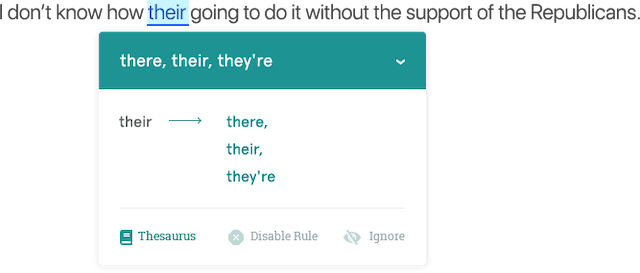





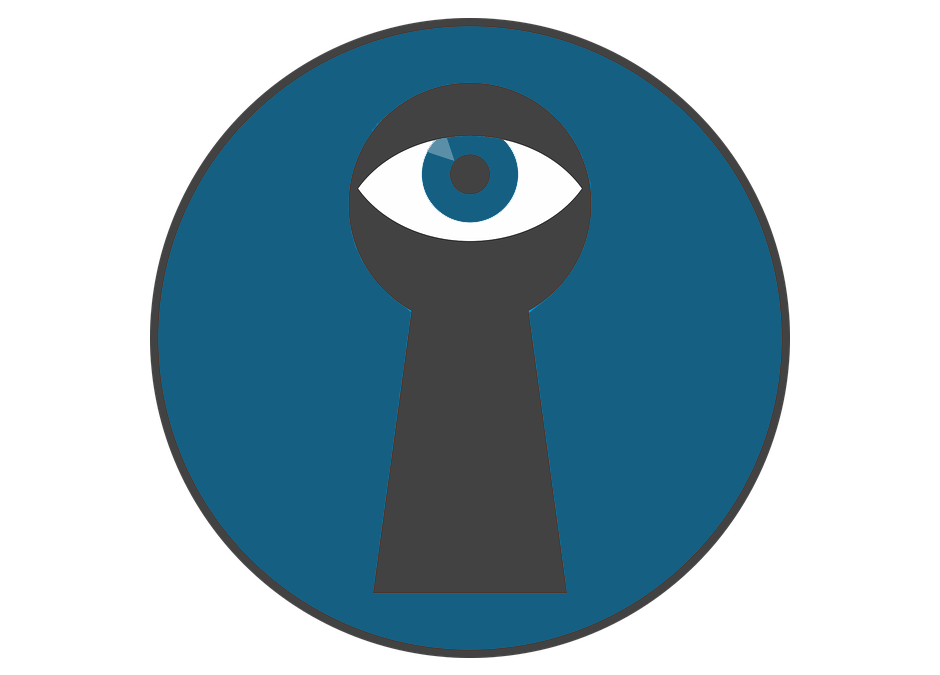


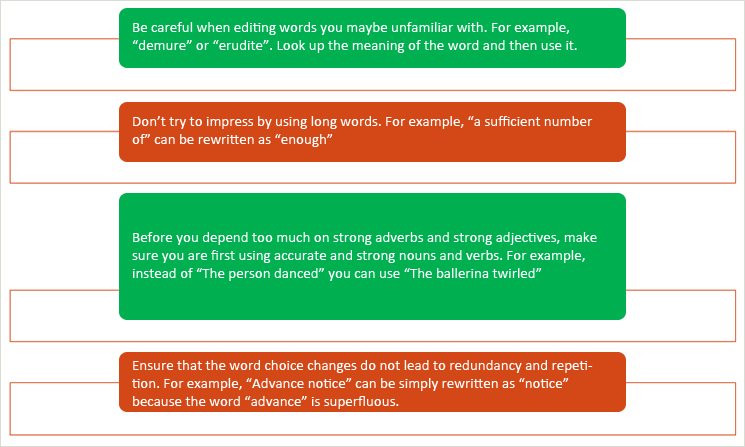


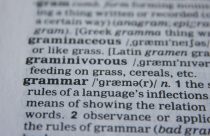

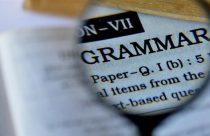


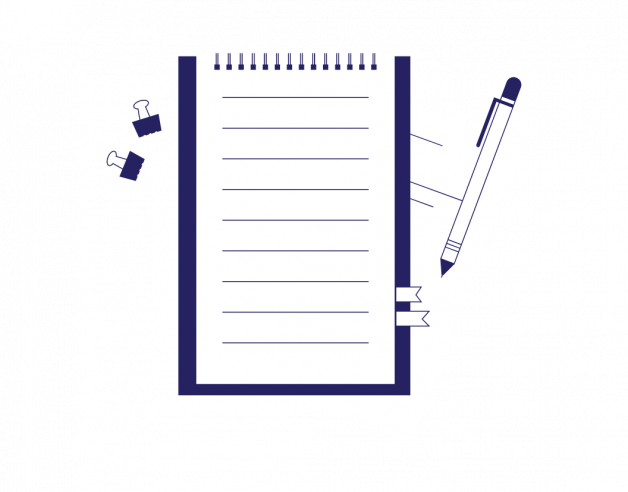





IMAGES
VIDEO
COMMENTS
The following words and phrases are considered too informal for a dissertation or academic paper. Taboo. Example. Alternative. A bit. The interviews were a bit difficult to schedule. The interviews were (difficult/somewhat difficult) to schedule. A lot of, a couple of. A lot of studies.
In most academic writing, you make an argument to support a thesis. To make a strong argument, you'll need to convince readers of your points. Consider these two sentences: ... Better: The theme of community is central in Russian literature. In each of the above examples, the second sentence employs a word with a more precise meaning and is ...
Academic writing is a formal style of writing used in universities and scholarly publications. You'll encounter it in journal articles and books on academic topics, and you'll be expected to write your essays, research papers, and dissertation in academic style. Academic writing follows the same writing process as other types of texts, but ...
Table of contents. Step 1: Reading the text and identifying literary devices. Step 2: Coming up with a thesis. Step 3: Writing a title and introduction. Step 4: Writing the body of the essay. Step 5: Writing a conclusion. Other interesting articles.
The body of the essay of the essay should relate to the issues you outline in your introduction. It also needs a coherent structure: if you have used your introduction to identify the key issues of your discussion, structuring the essay becomes easier, as you can address these issues in separate paragraphs.
If you conclude that both sides have merit, your argument should at least propose a way of navigating between them. Make sure that by the end of your essay, your reader knows what your opinion is. 3. The polemic. Try not to make your reader think of you shouting at them from a soapbox.
Academic writing refers to a style of expression that researchers use to define the intellectual boundaries of their disciplines and specific areas of expertise. Characteristics of academic writing include a formal tone, use of the third-person rather than first-person perspective (usually), a clear focus on the research problem under ...
Basics of Avoiding Bias. Writers should write objectively and inclusively to receive respect and trust from readers, as well as to avoid alienating readers. To be objective means to write with curiosity, rather than having a preset opinion, and to engage with research, rather than presenting a personal preference.
Harvard College Writing Center 5 Asking Analytical Questions When you write an essay for a course you are taking, you are being asked not only to create a product (the essay) but, more importantly, to go through a process of thinking more deeply about a question or problem related to the course. By writing about a
Guide to Academic Writing • 1 1. Forms of writing: essay and seminar paper The module handbooks of our BA, MA and teacher training programs distinguish two types of presenting your research and thinking in writing: academic essays and seminar papers. Both are forms of academic writing and therefore follow the same basic rules.
Using First-Person Pronouns. In most academic writing, first-person pronouns should be avoided. For instance, when writing a research project, words such as "I," "we," "my," or "our" should probably not be used. The same principle applies to lab reports, research papers, literature reviews, and rhetorical analyses, among many ...
Here are some key steps to writing a strong conclusion: 1. Summarize the key points. The first step in writing the conclusion is to summarize the key points of your essay. This might involve restating your research question, summarizing your findings, and reiterating your arguments. 2.
Most students, however, will commit many errors before learning the art of academic essay writing. While you can't avoid writing essays, you can avoid making some of these common mistakes: Contents: Writing a Synopsis, Not An Analytical Essay. Not Having a Strong Thesis Statement. Using Too Many Quotes in An Essay. Plagiarism.
The following is a chart that supplies the standard DOs and DON'Ts of academic writing at university. Some of these points may vary depending on the writing style and the departmental guidelines. Always check for style guides before starting the writing process to ensure that there are no additional style requirements or variations in preference.
INTRODUCTION. Writing the literature review (LR) is often viewed as a difficult task that can be a point of writer's block and procrastination in postgraduate life.Disagreements on the definitions or classifications of LRs may confuse students about their purpose and scope, as well as how to perform an LR.Interestingly, at many universities, the LR is still an important element in any ...
The preceding categories suggest that writing is a linear process — that is, that you will follow these steps in the following order: prewriting→researching→outlining→drafting→revising→feedback→re-revising→publishing. The reality of the writing process, however, is that as you write you shuttle back and forth in these stages.
Pecorari, Diane. "Good and original: Plagiarism and patchwriting in academic second-language writing." Journal of Second Language Writing 12.4 (Dec. 2003), 317-345. Perry, Bob. "Exploring Academic Misconduct: Some Insights into Student Behaviour." Active Learning in Higher Education 11.2 (2010), 97-108.
The writer of the academic essay aims to persuade readers of an idea based on evidence. The beginning of the essay is a crucial first step in this process. In order to engage readers and establish your authority, the beginning of your essay has to accomplish certain business. Your beginning should introduce the essay, focus it, and orient ...
Revision 1: "Conventional wisdom" is a relatively new term. Reason for change: The first sentence uses a complex word, whereas in the second sentence, it is substituted by a simple word with a clear meaning. Example 2: It was difficult to comprehend. Revision 2: It was difficult to understand.
And to ensure this, there are five things you should avoid in academic writing: Plagiarism - Every source you use in an essay should be clearly cited. Informality - Use formal, academic language in your writing. Wordiness - Keep your writing concise by avoiding padding words. Biased language - Look out for biased language and stereotypes.
Instructor Amy Bonn. Amy has taught college and law school writing courses. She holds a master's degree in English and a law degree. Cite this lesson. Writing academic articles or assignments can ...
APA prefers that writers use the first person for clarity and self-reference. To promote clear communication, writers should use the first person, rather than passive voice or the third person, to indicate the action the writer is taking. Example of passive voice: In this study, data were collected using intensive interviews.
It's essential for essays, research papers, and other assignments in these subjects. General Guidelines/ Rules of MLA Formatting. The first step to learning how to write an essay in MLA format for students is to get familiar with the general guidelines. It's all about following the rules to get your paper formatted in the MLA style: Margins ...
At the end of the day, every admission office just wants to know more about you, what you value, and what excites you. They want to hear about your experiences through your own words and in your ...
Students will write one research paper in this class and sit for two formal exams: a midterm covering everything up to that point in the semester, and a comprehensive final. Probable texts include the following:The Norton Anthology of English Literature: The Middle Ages. Ed. Alfred David, M. H. Abrams, and Stephen Greenblatt. 9th ed.
It's natural for them to imitate that style when they start to write for publication; (2) The ultimate goal of science writing is to increase collective understanding, but the immediate goal is acceptance (by the journal editors, the thesis committee, the boss, or whoever decides whether the report goes forward).